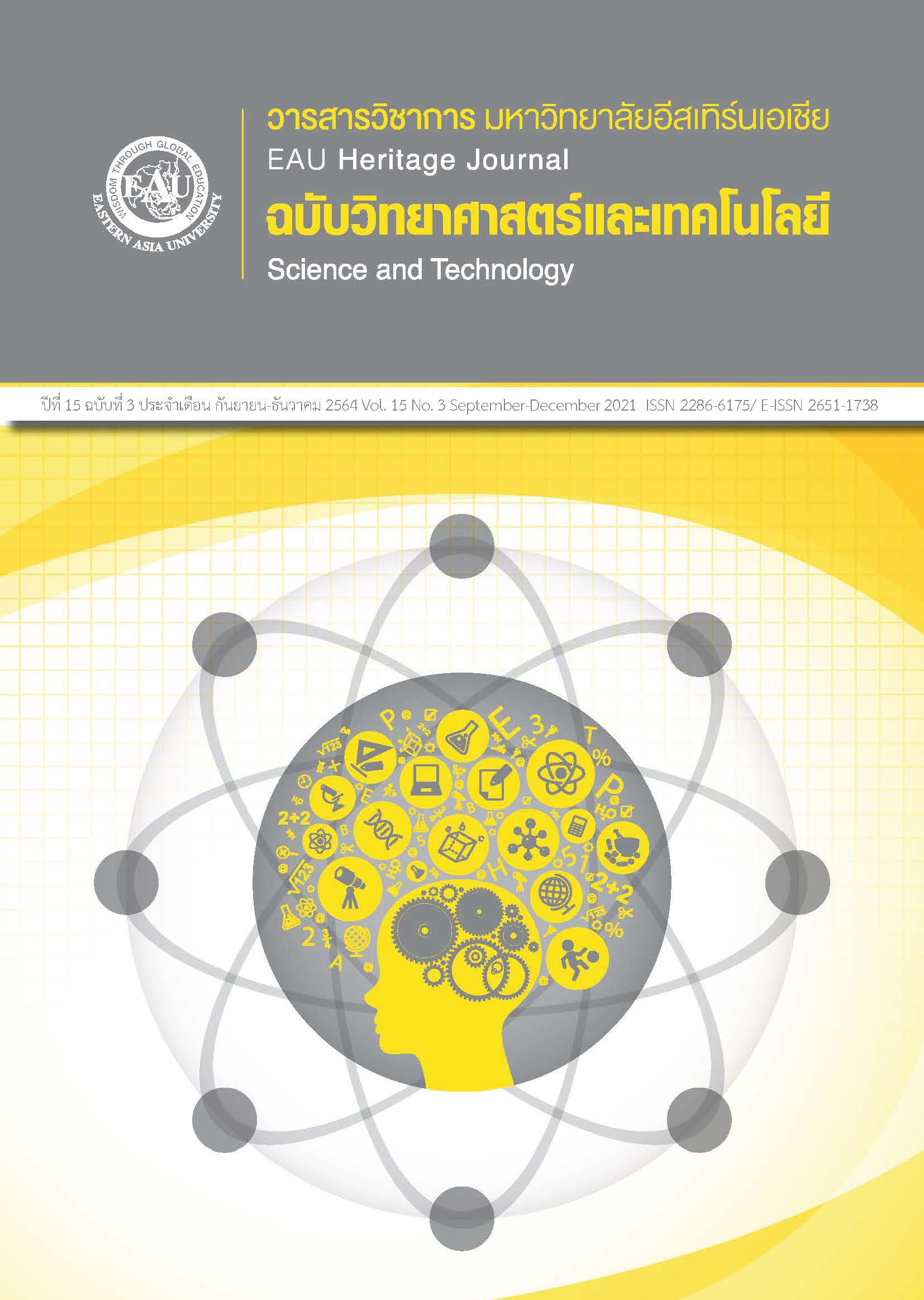การส่งเสริมความรู้ทางโภชนาการผ่านกิจกรรมการเล่นเกมในนักเรียนระดับประถมศึกษาตอนปลายที่มีภาวะโภชนาการเกิน
คำสำคัญ:
เกม; นักเรียนระดับประถมศึกษาตอนปลาย; ความรู้ทางโภชนาการ; ภาวะโภชนาการเกินบทคัดย่อ
งานวิจัยนี้เป็นการวิจัยแบบกึ่งทดลอง (quasi-experimental research) โดยมีวัตถุประสงค์เพื่อศึกษาผลของการส่งเสริมความรู้ทางโภชนาการผ่านกิจกรรมการเล่นเกมในนักเรียนระดับประถมศึกษาตอนปลายที่มีภาวะโภชนาการเกิน โดยเลือกกลุ่มตัวอย่างแบบเจาะจง ณ โรงเรียนวันครู 2502 จำนวน 47 คน อายุระหว่าง 9-12 ปี เครื่องมือที่ใช้ในการวิจัยประกอบด้วยเครื่องมือที่ใช้ในการทดลองและเครื่องมือในการรวบรวมข้อมูลผนวกเข้าด้วยกัน ซึ่งรูปแบบการส่งเสริมความรู้ทางโภชนาการผ่านกิจกรรมการเล่นเกมพัฒนามาจากหลักการประเมินภาวะโภชนาการและเกมนันทนาการสอดแทรกเนื้อหาความรู้ทางโภชนาการโดยอ้างอิงมาจากแนวทางการดูแลสุขภาพทฤษฎีหลัก 3 อ. และแบบทดสอบความรู้ก่อนและหลังเข้าร่วมกิจกรรม ผลการวิจัยพบว่าจากกิจกรรมเกมที่สอดแทรกการประเมินภาวะโภชนาการ กลุ่มตัวอย่างส่วนใหญ่มีน้ำหนักเกินเกณฑ์ (ร้อยละ 80.9) และมีความถี่ในการบริโภคอาหารที่สัมพันธ์กับภาวะโภชนาการเกิน ประเภทขนม เครื่องดื่มที่มีน้ำตาล และอาหารจานด่วน 3-4 ครั้งต่อสัปดาห์ (ร้อยละ 50 ของกลุ่มตัวอย่างขึ้นไป) ผลการส่งเสริมความรู้ทางโภชนาการจากเกมนันทนาการ พบว่า กลุ่มตัวอย่างรู้จักชนิดอาหารประเภท ผักและผลไม้ ซึ่งจัดเป็นอาหารหมวดหมู่ที่ดีต่อสุขภาพ โดยมีคะแนนเฉลี่ยสูงสุด 8.5 คะแนน นอกจากนี้ยังพบว่า กลุ่มตัวอย่างรู้จักแยกชนิดอาหารที่มีผลต่อการเพิ่มน้ำหนักตัวได้ การประเมินด้านความรู้หลังเข้าร่วมกิจกรรมพบว่าหมวดหมู่อาหารที่ส่งผลต่อการเพิ่มน้ำหนักตัวกลับเป็นสิ่งที่กลุ่มตัวอย่างทุกคนตอบได้ถูกต้อง (ร้อยละ 100) ทั้งก่อนและหลังเข้าร่วมกิจกรรม การส่งเสริมความรู้ทางโภชนาการผ่านกิจกรรมการเล่นเกมที่เปิดโอกาสให้ผู้เรียนลงมือทำ ร่วมอภิปราย ร่วมฝึกทักษะ และสื่อสารทำให้ผลการเรียนรู้ของกลุ่มตัวอย่างเพิ่มขึ้นโดยเฉพาะการรู้จักแยกแยะอาหารที่มีผลต่อการเพิ่มน้ำหนักตัว
เอกสารอ้างอิง
Aekplakorn, W. (2014). Thai Children national health examination survey, NHES V. Retrieved from https://www.hiso.or.th/hiso/picture/reportHealth/Thai2014kid/report2014kid_10.pdf. (in Thai)
Berkey, C. S., Rockett, H. R., Willett, W. C., & Colditz, G. A. (2005). Milk, dairy fat, dietary calcium, and weight gain: A longitudinal study of adolescents. Archives of Pediatrics & Adolescent Medicine, 159(6), 543–550. https://doi.org/10.1001/archpedi.159.6.543
Blundell, J. E., & Macdiarmid, J. I. (1997). Passive overconsumption. Fat intake and short-term energy balance. Annals of the New York Academy of Sciences, 827, 392–407. https://doi.org/10.1111/j.1749-6632.1997.tb51850.x
Bureau of Nutrition Department of Health, Ministry of Public Health. (2000). Growth standards based on length/height, weight and age. Retrieved from https://bit.ly/3eyjeKB (in Thai)
Bureau of Nutrition Department of Health, Ministry of Public Health. (2015). Nutrition promotion guidelines in Children Health Clinic. Retrieved from https://bit.ly/2SyCRJU (in Thai)
Bureau of Nutrition Department of Health, Ministry of Public Health. (2015). Guideline for organization to promote growth development. Retrieved from http://nutrition.anamai.moph.go.th/images/file.pdf (in Thai)
Centers for Disease Control and Prevention (CDC). (2015). Measuring children's height and weight accurately at home. Retrieved from https://www.cdc.gov/healthyweight/assessing/bmi/childrens_bmi/measuring_children.html
Department of Physical Education. (2016). Guideline of recreation. Bangkok: The War Veterans Organization of Thailand under Royal Patronage of His majesty the King Printing. (in Thai)
Dale, E. (1969). Audio-visual methods in teaching (3rd ed.). New York: Dryden Press. https://www.researchgate.net/figure/283011989_fig1_Figure-2-Edgar-Dale-Audio-Visual-Methods-in-Teaching-3rd-Edition-Holt-Rinehart-and
Gibson, R. S. (2005). Principles of nutritional assessment. New York: Oxford University Press.
Intasara, W. (2019). Game Based Learning the latest trend education 2019. Retrieved from https://wbsc.dusit.ac.th/pluginfile.php/534/mod_forum/attachment/4320/GBL%20DOC.pdf. (in Thai)
Kelishadi, R., Mirmoghtadaee, P., Najafi, H., & Keikha, M. (2015). Systematic review on the association of abdominal obesity in children and adolescents with cardio-metabolic risk factors. Journal of Research in Medical Sciences: The Official Journal of Isfahan University of Medical Sciences, 20(3), 294–307.
Malik, V. S., Schulze, M. B., & Hu, F. B. (2006). Intake of sugar-sweetened beverages and weight gain: A systematic review. The American Journal of Clinical Nutrition, 84(2), 274–288. https://doi.org/10.1093/ajcn/84.1.274
Meejinda, N., Siriprohmpathara, C., & Taearak, K. (2020). Factors associated with body mass index of students at Sirindhorn College of Public Health, Khon Kaen. Journal of Health Science and Community Public Health, 3(1), 83-94. (in Thai)
Nakasan, N., & Nakasan, C. (2016). Game: Innovation for creative education. Romphruek Journal, 34(3), 160-182. (in Thai)
Nation Statistical Office. (2017). The 2017 food consumption behavior survey. Retrieved from http://www.nso.go.th/sites/2014/DocLib13/.pdf. (in Thai)
Ochiai, H., Shirasawa, T., Nishimura, R., Yoshimoto, T., Minoura, A., Oikawa, K., Miki, A., Hoshino, H., & Kokaze, A. (2020). Changes in overweight/obesity and central obesity status from preadolescence to adolescence: a longitudinal study among schoolchildren in Japan. BMC Public Health, 20(1), 241. https://doi.org/10.1186/s12889-020-8343-3
Office of the Basic Education Commission. (2005). Analytical thinking. Retrieved from http://www.reo3.moe.go.th/web/images/download/Policy2561/Policy_04.pdf. (in Thai)
Piyasil, W. (2005). Parenting guide book aged 6-12 year old. Bangkok: Kurusapa Printing Ladphrao. (in Thai)
Rakthai, D., Cheeprasop, N., Singhasaem P., Suwanwela, S., & Leartwanawattana, J. (2021). Effects of using experiential learning to improve knowledge, awareness and behavior of healthy and media literacy food consumption in Prathom Suksa Students in Trang Province. Princess of Naradhiwas University Journal, 13(1), 1-21. (in Thai)
Sahoo, K., Sahoo, B., Choudhury, A. K., Sofi, N. Y., Kumar, R., & Bhadoria, A. S. (2015). Childhood obesity: Causes and consequences. Journal of Family Medicine and Primary Care, 4(2), 187–192. https://doi.org/10.4103/2249-4863.154628
Serra-Majem, L., & Bautista-Castaño, I. (2015). Relationship between bread and obesity. British Journal of Nutrition, 113(S2), S29-S35. doi:10.1017/S0007114514003249
Tangkittipaporn, J. (2013). General psychology. Bangkok: Chulalongkorn University Press (CUPRINT). (in Thai)
Thai Health Promotion Foundation. (2017). 3A health behavior. Retrieved from https://dol.thaihealth.or.th/resourcecenter/sites/default/files/documents/26aenwthaangkaarduuaelsukhphaaphtaamhlak_3_._aahaar_kkamlangkaay_aarmn_1.pdf. (in Thai)
Tuntiakarat, S., & Khuneepong, A. (2017). Factors associated with the overweight of primary students in public school. Journal of Preventive Medicine Association of Thailand, 7(3), 272-279 (in Thai)
World Health Organization (WHO). (2020). Obesity and overweight. Retrieved from https://www.who.int/news-room/fact-sheets/detail/obesity-and-overweight
Zimmet, P., Alberti, G., Kaufman, F., Tajima, N., Silink, M., Arslanian, S., Wong, G., Bennett, P., Shaw, J., Caprio, S., & International Diabetes Federation Task Force on Epidemiology and Prevention of Diabetes. (2007). The metabolic syndrome in children and adolescents. Lancet (London, England), 369(9579), 2059–2061. https://doi.org/10.1016/S0140-6736(07)60958-1







